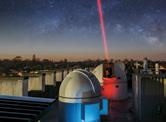Western Australian Space Snapshot
• Over 130 international and Australian organisations operating space and space-related services.
• Home to world-class space mission operations services.
• Home to the only commercial optical communications ground network in the Southern Hemisphere with world-leading phase stabilisation and self-guiding optical technology.
• Co-host of the $3 billion Square Kilometre Array – the largest radio telescope in the world.
• Location of Australia’s only Satellite Park designated by the Australian Communications and Media Authority, and the largest radio quiet zone in the Southern Hemisphere.
• Home to the largest planetary research group in the Southern Hemisphere.
• Hosts significant space infrastructure for both civil and defence applications, including facilities for five international space agencies and two of ESA’s four deep space ground stations.
• Home to the most powerful public and commercial supercomputers in the Southern Hemisphere, which also actively support space activities.
• A diverse and strong economy with significant demand for space technology and data across mining, agriculture, defence, energy, and maritime industry sectors.
• Host of the annual Indo-Pacific Space and Earth Conference.

Western Australia has significant capabilities in the space industry sector with the following advantages and opportunities:
• Southern Hemisphere location and longitude ideal for launch and returns, space situational awareness and global coverage of space assets.
• Ideal environmental conditions: geologically stable with clear skies, large arid areas with minimal radio interference and radio-quiet zones.
• Partnerships and extensive activity with international space agencies and private space companies.
• Substantial capabilities in space mission operations; space communications; space situational awareness; space systems and hardware; space enabled services and data analytics; technology transfer; astronomy; and planetary science.
• Strong economy with a significant demand for space data, satellite services, and technology transfer with Western Australia’s key industries (mining, energy, agriculture, defence, maritime).
• Vibrant R&D ecosystem: home to five universities and various research institutions with established expertise in space sciences and related fields.
• Diverse and highly skilled workforce, with a pipeline of skilled workers in space and spacerelated fields.

Discover more about the Western Australian space sector. You can also explore the Capability Directory and Strategy here.
wa.gov.au/jtsi space@jtsi.wa.gov.au

Western Australia has been integral to the global space industry for over 60 years, supporting international space agencies, the commercial space sector and major space missions.
Today, Western Australia is home to more than 130 international and Australian space organisations and provides space mission, communication and situational awareness services; deep space and planetary insights; end to-end Earth observation and space data analytics solutions; and technology transfer across space and terrestrial industry sectors.
Building on Western Australia’s significant space infrastructure, leading space science and research, vibrant space ecosystem and geographical advantages for the global coverage of space assets, Western Australia is emerging as a critical Indo-Pacific space hub.










